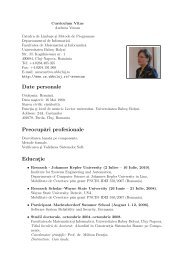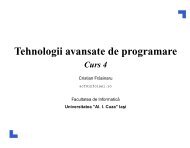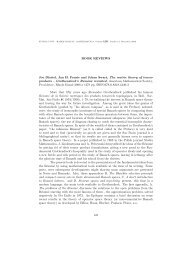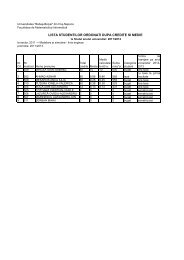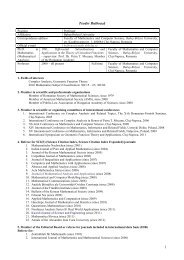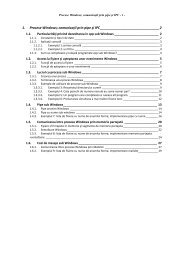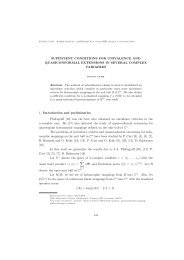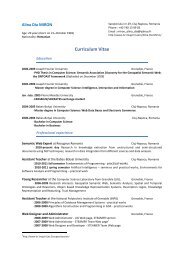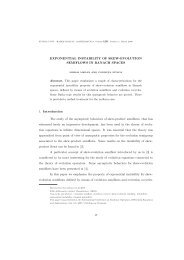CONTENTS
CONTENTS
CONTENTS
Create successful ePaper yourself
Turn your PDF publications into a flip-book with our unique Google optimized e-Paper software.
KNOWLEDGE ENGINEERING: PRINCIPLES AND TECHNIQUES<br />
Proceedings of the International Conference on Knowledge Engineering,<br />
Principles and Techniques, KEPT2009<br />
Cluj-Napoca (Romania), July 2–4, 2009, pp. 194–197<br />
RAPID PROTOTYPING OF CONVERSATIONAL WEB FLOWS<br />
I. LAZĂR, S. MOTOGNA, AND B. PÂRV(1)<br />
Abstract. In this paper we present a rapid prototyping development approach<br />
for conversational web flows based on Model-Driven Architecture (MDA). Prototypes<br />
are defined as executable UML models. In order to ensure simple and fast<br />
definition of UML models, we apply the DRY (“don’t repeat yourself”) principle<br />
and the concept of “convention over configuration”. Update transformations<br />
in the small may be applied on model elements in order to rapidly create new<br />
elements based on some conventions.<br />
1. Introduction<br />
Prototyping refers to a development approach centered on developing prototypes<br />
(executable model of a system that reflects a subset of its properties) early in the<br />
development process, to allow early feedback and analysis [4]. Prototyping techniques<br />
based on MDA rely on using the UML and profiles. Today, the effort of defining a<br />
standard execution semantics for UML enters the final state of adoption through<br />
Foundational UML (fUML) which defines a “basic virtual machine for the UML” [7].<br />
The proposed solution is a prototyping approach for conversational web flows<br />
based on the following techniques. The model prototypes are captured as executable<br />
fUML models [7] and conform to iComponent profile [6]. For simple and fast definition<br />
of fUML models we use model transformations [3] for generating new elements<br />
based on existing best practices for developing web applications.<br />
After this introductory section, the next one presents iComponent profile, the<br />
third section describes our rapid prototyping method, and the last one draws conclusions<br />
and future development plans.<br />
2. iComponent Profile<br />
iComponent (injected component) [6] has been designed as a platform-independent<br />
component model for service-oriented applications (SOA). Recently, we have<br />
extended iComponent for prototyping SOA on OSGi platform [5] by adding new<br />
stereotypes for domain classes and Model-View-Controller (MVC) architectures - see<br />
Figure 1. A short description of this profile is given below (see [5]).<br />
2000 Mathematics Subject Classification. 68U07, 68U20, 68U35.<br />
Key words and phrases. rapid system prototyping, conversational web flow, executable UML,<br />
contextual component, dependency injection.<br />
194<br />
c○2009 Babe¸s-Bolyai University, Cluj-Napoca



